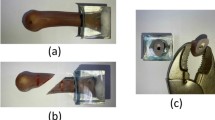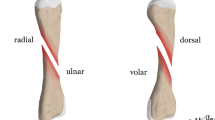Abstract
The lag screw technique has historically been a successful and accepted way to treat oblique metacarpal fractures. However, it does take additional time and involve multiple steps that can increase the risk of fracture propagation or comminution in the small hand bones of the hand. An alternate fixation technique uses bicortical interfragmentary screws. Other studies support the clinical effectiveness and ease of this technique. The purpose of this study is to biomechanically assess the strength of the bicortical interfragmentary screw versus that of the traditional lag screw. Using 48 cadaver metacarpals, oblique osteotomies were created and stabilized using one of four methods: 1.5 mm bicortical interfragmentary (IF) screw, 1.5 mm lag technique screw, 2.0 mm bicortical IF screw, or 2.0 mm lag technique screw. Biomechanical testing was performed to measure post cyclic displacement and load to failure. Data was analyzed using one-way analysis of variance (ANOVA). There was no significant difference among the fixation techniques with regard to both displacement and ultimate failure strength. There was a slight trend for a higher load to failure with the 2.0 mm IF screw and 2.0 mm lag screw compared to the 1.5 mm IF and 1.5 mm lag screws, but this was not significant. Our results support previously established clinical data that bicortical interfragmentary screw fixation is an effective treatment option for oblique metacarpal fractures. This technique has clinical importance because it is an option to appropriately stabilize the often small and difficult to control fracture fragments encountered in metacarpal fractures.







Similar content being viewed by others
References
Black D, Mann RJ, Constine R, Daniels AU. Comparison of internal fixation techniques in metacarpal fractures. J Hand Surg Am 1985;10(4):466–72.
Bosscha K, Snellen JP. Internal fixation of metacarpal and phalangeal fractures with AO minifragment screws and plates: a prospective study. Injury 1993;24(3):166–8.
Firoozbakhsh KK, Moneim MS, Howey T, Castaneda E, Pirela-Cruz MA. Comparative fatigue strengths and stabilities of metacarpal internal fixation techniques. J Hand Surg Am 1993;18(6):1059–68.
Firoozbakhsh KK, Moneim MS, Doherty W, Naraghi FF. Internal fixation of oblique metacarpal fractures. A biomechanical evaluation by impact loading. Clin Orthop Relat Res 1996;325:296–301.
Fischer KJ, Bastidas JA, Provenzano DA, Tomaino MM. Low-profile versus conventional metacarpal plating systems: a comparison of construct stiffness and strength. J Hand Surg Am 1999;24(5):928–34.
Ford DJ, el-Hadidi S, Lunn PG, Burke FD. Fractures of the metacarpals: treatment by A. O. screw and plate fixation. J Hand Surg Br 1987;12(1):34–7.
Fusetti C, Meyer H, Borisch N, Stern R, Santa DD, Papaloizos M. Complications of plate fixation in metacarpal fractures. J Trauma 2002;52(3):535–9.
Page SM, Stern PJ. Complications and range of motion following plate fixation of metacarpal and phalangeal fractures. J Hand Surg Am 1998;23(5):827–32.
Prevel CD, McCarty M, Katona T, Moore K, Jackson JR, Eppley BL, Sood R. Mini and micro plating of phalangeal and metacarpal fractures: a biomechanical study. J Hand Surg Am 1995;20(1):44–9.
Putnam MD, Meyer NJ, Nelson EW, Greensway D, Lewis JL. Distal radial metaphyseal forces in an extrinsic grip model: implications for postfracture rehabilitation. J Hand Surg Am 2000;25(3):469–75.
Rüedi TP, Murphy WM, Colton CL, et al. AO Principles of fracture management. Thieme: New York; 2000. Chapter 3.2.1.
Roth JJ, Auerbach DM. Fixation of hand fractures with bicortical screws. J Hand Surg Am 2005;30(1):151–3.
Stern PJ, Wieser MJ, Reilly DG. Complications of plate fixation in the hand skeleton. Clin Orthop Relat Res 1987;214:59–65.
Stern PJ. Management of fractures of the hand over the last 25 years. J Hand Surg Am 2000;25(5):817–23.
Trevisan C, Morganti A, Casiraghi A, Marinoni EC. Low-severity metacarpal and phalangeal fractures treated with miniature plates and screws. Arch Orthop Trauma Surg 2004;124(10):675–80.
Vanik RK, Weber RC, Matloub HS, Sanger JR, Gingrass RP. The comparative strengths of internal fixation techniques. J Hand Surg Am 1984;9(2):216–21.
Author information
Authors and Affiliations
Corresponding author
About this article
Cite this article
Liporace, F.A., Kinchelow, T., Gupta, S. et al. Minifragment Screw Fixation of Oblique Metacarpal Fractures: A Biomechanical Analysis of Screw Types and Techniques. HAND 3, 311–315 (2008). https://doi.org/10.1007/s11552-008-9108-0
Received:
Accepted:
Published:
Issue Date:
DOI: https://doi.org/10.1007/s11552-008-9108-0




